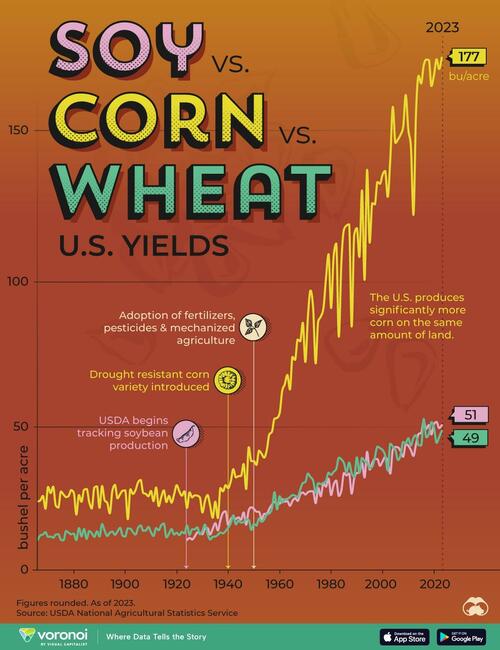Charting 150 Years Of Corn, Wheat, & Soy Yields In America
America can grow three-times as much corn from a single acre of land as it can wheat and soy. This is the story of how corn became king in America.
To understand how this happened, Visual Capitalst’s Pallavi Rao visualizes the yields (measured in bushels per acre) for all three crops over the last century.
Data for this graphic is sourced from the National Agricultural Statistics Service, maintained by the U.S. Department of Agriculture.
The Corny American Love Story
In 2023, America produced 500 million metric tons of corn, a figure so astoundingly large, it compares to the weight of 7,000 Great Pyramids of Gaza. And all of that corn was grown on 92 million acres of land—an area bigger than Malaysia.
But America’s colossal corn-producing prowess didn’t always exist, as seen in the yield data from 1866.
YearCorn YieldWheat YieldSoybean Yield
186624.311.0N/A
186724.712.6N/A
186826.212.9N/A
186921.813.7N/A
187029.312.1N/A
187127.212.2N/A
187229.411.8N/A
187322.912.9N/A
187422.213.0N/A
187527.711.1N/A
187626.710.9N/A
187725.814.1N/A
187826.213.5N/A
187928.213.0N/A
188027.313.2N/A
188119.811.0N/A
188226.515.1N/A
188324.212.3N/A
188428.314.8N/A
188528.611.4N/A
188624.114.1N/A
188721.913.3N/A
188829.112.1N/A
188929.514.0N/A
189022.112.2N/A
189129.616.5N/A
189224.714.2N/A
189323.812.4N/A
189420.213.5N/A
189528.013.9N/A
189630.012.8N/A
189725.414.0N/A
189826.815.2N/A
189928.012.5N/A
190028.112.2N/A
190118.215.0N/A
190228.514.9N/A
190326.913.7N/A
190428.212.9N/A
190530.915.2N/A
190631.716.0N/A
190727.214.2N/A
190826.914.3N/A
190926.115.5N/A
191027.913.7N/A
191124.412.4N/A
191229.115.1N/A
191322.714.4N/A
191425.816.1N/A
191528.116.7N/A
191624.111.9N/A
191726.213.2N/A
191823.914.8N/A
191926.812.9N/A
192029.913.5N/A
192127.812.7N/A
192226.313.8N/A
192327.813.3N/A
192422.116.011.0
192527.412.811.7
192625.714.711.2
192726.414.712.2
192826.315.413.6
192925.713.013.3
193020.514.213.0
193124.516.315.1
193226.513.115.1
193322.811.212.9
193418.712.114.9
193524.212.216.8
193618.612.814.3
193728.913.617.9
193827.813.320.4
193929.914.120.9
194028.915.316.2
194131.216.818.2
194235.419.519.0
194332.616.418.3
194433.017.718.8
194533.117.018.0
194637.217.220.5
194728.618.216.3
194843.017.921.3
194938.214.522.3
195038.216.521.7
195136.916.020.8
195241.818.420.7
195340.717.318.2
195439.418.120.0
195542.019.820.1
195647.420.221.8
195748.321.823.2
195852.827.524.2
195953.121.623.5
196054.726.123.5
196162.423.925.1
196264.725.024.2
196367.925.224.4
196462.925.822.8
196574.126.524.5
196673.126.325.4
196780.125.824.5
196879.528.426.7
196985.930.627.4
197072.431.026.7
197188.133.927.5
197297.032.727.8
197391.331.627.8
197471.927.323.7
197586.430.628.9
197688.030.326.1
197790.830.730.6
1978101.031.429.4
1979109.534.232.1
198091.033.526.5
1981108.934.530.1
1982113.235.531.5
198381.139.426.2
1984106.738.828.1
1985118.037.534.1
1986119.434.433.3
1987119.837.733.9
198884.634.127.0
1989116.332.732.3
1990118.539.534.1
1991108.634.334.2
1992131.539.337.6
1993100.738.232.6
1994138.637.641.4
1995113.535.835.3
1996127.136.337.6
1997126.739.538.9
1998134.443.238.9
1999133.842.736.6
2000136.942.038.1
2001138.240.239.6
2002129.335.038.0
2003142.244.233.9
2004160.343.242.2
2005147.942.043.1
2006149.138.642.9
2007150.740.241.7
2008153.344.839.7
2009164.444.344.0
2010152.646.143.5
2011146.843.642.0
2012123.146.240.0
2013158.147.144.0
2014171.043.747.5
2015168.443.648.0
2016174.652.751.9
2017176.646.449.3
2018176.447.650.6
2019167.551.647.4
2020171.449.751.0
2021176.744.551.7
2022173.446.549.6
2023177.348.650.6
In fact, for the first half of the 20th century, yields remained range-bound between 20–30 bushels per acre.
Then, there were two miracles. First, the introduction of a drought-resistant variety of the crop (1940s). Then, the introduction of fertilizer, pesticides, and mechanized agriculture (1950s).
Since then, corn yields have climbed at a rate of roughly 1.9 bushel/acre, per year.
Why Are Corn Yields So Much Higher Than Soy and Wheat?
Corn has a high energy density which directly translates into more food per acre. It’s also better at turning sunlight into biomass, meaning it grows faster. Both of these qualities make it the preferred crop to sow.
Compared to soybean (mostly animal feed and export to Asia) and wheat (mostly for humans), it’s also a far more versatile grain.
All of this means it attracts significant investment for varied uses: in animal feed, biofuel production, and the creation of high-fructose corn syrup. This investment helps fund research into the continuous improvement of corn yields.
Despite lower yields compared to corn, the U.S. is still a major wheat producer. Check out Breaking Down Global Wheat Production, by Country, to see where it ranks.
Tyler Durden
Sun, 09/22/2024 – 20:25

